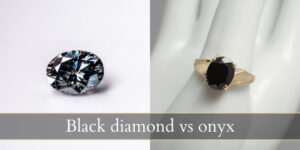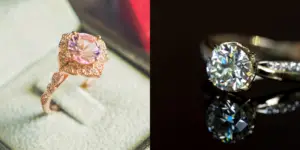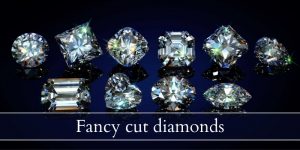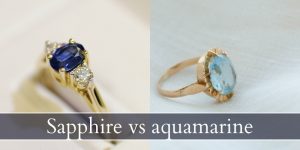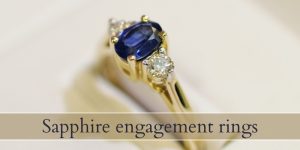Diamond cut and diamond clarity are two important factors you’ll be facing very often when shopping for a diamond. These two matter, and especially when together. One matters more than the other, to the point where it it can completely ruin a diamond if it’s not the best. But not all diamonds are made the same and not everyone can afford the premium, top-notch ones. So let’s take a look at which matters more clarity or cut quality. Surely there’s a way to get the best of both worlds.
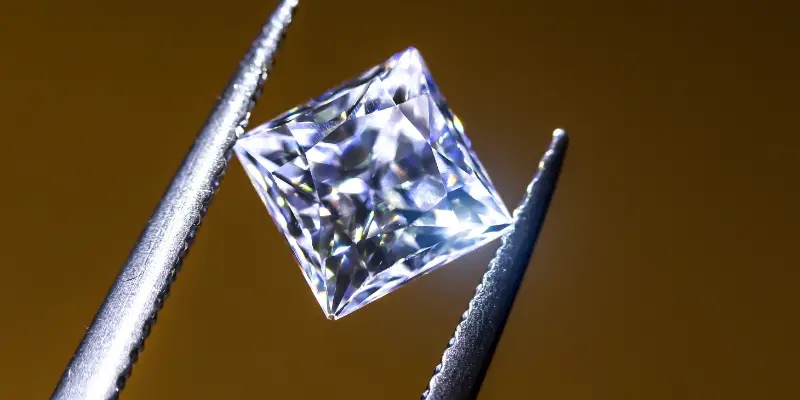
Diamond cut vs clarity
Diamond cut quality outweighs diamond clarity when it comes to light performance and overall beauty in a diamond. The reason is that a very well or perfectly cut diamond can mitigate the damage done by a lower clarity rating, and in some cases can hide it completely when the diamond is face up. Diamond cut quality has the highest impact on sparkle and price point, and is the one area where you should aim for the best in a diamond.
If you’re sorting through an online catalog keep the cut quality at the vendor’s top two grades, and then fiddle with the rest of the specs (carat size, color, clarity, natural or lab grown). Keep in mind that online diamond vendors have very different cut quality ratings than what you may be used to.
Let’s take a look at what diamond cut is, how it’s different from cut style, what diamond clarity is, how to get the best value for your money, and also chime in on whether lab diamonds can offer you a better deal when it comes to cut and clarity.
What is diamond cut ?
A diamond’s cut refers to the quality of the cut, not the shape or style. The usual grading for diamond cut is the GIA standard, which ranges form Poor to Excellent for most diamond cut styles. If you’re looking at online diamonds this grading system will not be available to you, only the site/company’s own cut grade scale. We strongly recommend buying diamonds in-person, from sellers that allow you to inspect the diamonds in person.
Whichever diamond you’re going for (princess, round, emerald cut, anything you like), please be very careful with the cut quality. You’ll notice that diamonds that are not round brilliant often don’t have the best cut on them. This is because round brilliants are the most common and sought-after diamond shapes, and jewelers compete to offer the best quality cut. But there is much lower interest in the other diamond shapes, so less interest form jewelers and lapidaries to offer the perfect, flawless cut quality. They’re not all poorly cut, but you’ll find more perfect round brilliants than any other shape.
So what does the diamond cut quality or grade look at ? Most of the time it’s a combination of:
- the depth of the cut (shallow, deep, uneven, loped to the side)
- how well the facets are aligned (they should have perfectly aligned angles to best reflect and disperse light)
- the girdle thickness, too much or too little affects light performance
- whether the culet is open or not
- how large the table is, also affecting light performance
Exactly what goes into grading a diamond’s cut quality can be a mystery if you’re not an actual gemologist, or work at one of the grading labs. But this is also the single most important thing about a diamond, as it directly affects sparkle and light performance, how large or small the diamond looks, whether it has any dull areas.
Want to know the best part ? Sometimes a diamond sounds great on paper, then you take a look at it under different lightings and notice that it’s not as extraordinary as the report suggested. Again, seeing a diamond in person makes a huge difference. Cut quality is immensely important, but it can fool people sometimes. Don’t go 100% by cut quality alone, but take it into strong consideration.
Read also: Diamond Color VS Clarity
Not all diamond certification companies work the same
Your diamond’s cut quality grade will be stated on the diamond report. This can be done by any diamond certification company, and this particular industry can be very shady since there are no regulations or laws about how to be such a company, how to grade, and how transparent you should be. Only a loose unspoken agreement between companies to operate roughly in the same way.
There are companies you can trust, and companies you can trust to rip you off. It’s important to know the most well-respected certification companies in your area of the world.
To further complicate things, each diamond may come with a report from a different lab. The most common lab report for natural diamonds is GIA and AGS in North America, and IGI for lab grown diamonds. If you’re in Europe the lab report can be from EGL or IGI.
Each diamond certification lab has slightly different standards for that is an Excellent cut diamond, and some may even have a different label for the top notch cut quality. Some may be very strict when grading cut quality but amazingly lax with clarity, or they extend their colorless range another 2 grades lower than others.
In short, a single grade on a single report will only show you what one particular company thinks of the diamond. Again, GIA, IGI, and AGS are the most trusted companies and they operate roughly the same and have very similar grading standards. Most diamond retailers will have diamonds certified from GIA or IGI.
Do not trust an in-house diamond report, they have every reason to cover flaws or inflate grades. Always look for an independent one, or get a second opinion.
Do not confuse diamond cut (quality) with diamond cut style
Diamond cut quality refers to how well the diamond is cut, while its cut style is the type of cut (brilliant or step cut). For example a round brilliant is a diamond cut style, and it can be of cut quality ranging from Poor to Excellent. The quality of the cut takes into account how well arranged the facets are, how deep or shallow the cut is (length from culet to crown), how thick the girdle is, whether any light escapes or leaks out of the diamond.
Of all the Cs of a diamond (cut, carat, color, and clarity) it’s cut that you absolutely need to see in person. A report sheet can only give you so much information. Seeing a diamond sparkle and comparing it to another one, in person, will make a huge difference.
What is diamond clarity ?
A diamond’s clarity is the level or amount of inclusions is has within its structure. This is also important when buying a diamond, as one inclusion can be reflected throughout the diamond, and can dull it, make it look foggy, or weaken the structure (depending on the size and placement).
Of course you can get the clearest possible diamond, but most of the time it’s not exactly worth getting the perfectly flawless ones. Any and all imperfections noted on a clarity grade are observed under 10x magnification, so the first few grades won’t even be visible to the naked eye. The usual clarity grade scale is (GIA), under 10x magnification:
- FL, flawless diamonds that have absolutely zero inclusions or marks
- IF, internally flawless diamonds that have no inclusions but may have scuffs or marks that are barely visible
- VVS1-VVS2, very very slightly included diamonds, inclusions are extremely hard to see, even magnified
- VS1 and VS2, very slightly included, inclusions are easier to notice but you still need a loupe for them
- SI1 and SI2, slightly included diamonds that may show very tiny inclusions when viewed with the naked eye
- I1, I2, I3 diamonds that are included and they are noticeable with the unaided eye
FL and IF diamonds are, of course, the top notch diamonds, There are no inclusions within the diamond to obstruct light. VVS1-2 diamonds are the next best thing, and their tiny inclusions still don’t affect light performance, almost at all. You can’t see their inclusions with the naked eye.
It’s at VS1-2 where light performance might change a bit, but this is heavily affected by exactly where the inclusion is, what kind it is (the fluffy, white, feathery kind or the gritty black spots), and how well the diamond is cut (even here it matters). In some cases the inclusion and its placement can give the diamonds a grey cast, or a significant contrast between light and dark areas. In other cases a VS2 diamond can still look virtually flawless, especially when face-up.
SI1 and lower will almost always be noticeably included, but again, it depends for each diamond. Inclusions placed towards the girdle are much easier to see when the diamond is face up. Inclusions deep within the diamond, so somewhere in the middle of the pavilion, are far harder to see.
Diamond cut affects sparkle the most
Of all the diamond Cs, the cut and its quality affects the sparkle the most. This is because the cut is how well each facet is aligned with one another, and thus how well light travels through, splits, reflects and then comes back through the table to your eyes. This is the main reason two diamonds that seem absolutely identical on paper will differ wildly under the spotlight.
Of course, a hazy (thus heavily included) diamond will not sparkle as much, even when it has a perfect cut quality. This is why a great diamond needs to have great balance between color, clarity, and cut quality, with the most attention spent on cut quality.
What if you’re looking at step cut diamonds, does cut quality affect them too ? Yes, even if step cut diamonds sparkle much less than brilliant cuts. A misaligned facet or a diamond cut too shallow will appear off, or it may white-out and lack contrast. In a way, you could say a step cut with a poor cut quality is more noticeable than a brilliant one, since you can clearly see into the diamond. So every mistake or imperfection in a diamond is immediately noticeable in a step cut.
You do want a higher clarity for a step cut diamond though, here it matters more than in a brilliant cut because, again, you can easily see into the diamond. Where a brilliant cut may hide a small inclusion by reflecting it into its many facets, a step cut will reveal it.
What is the best diamond cut and clarity ?
Assuming we’re discussing the popular round brilliant, the best cut and clarity grades (for money spent) are the Excellent cut, and clarity can go as low as VS2, depending on the exact diamond you’re looking at. Sometimes you may find an SI1 round brilliant with such as well placed (or well hidden) inclusion that light performance will not be heavily affected, especially if it has an Excellent cut.
Clarity is perhaps the most flexible diamond quality, and the one you could compromise on the most. Each diamond varies a little so again, check it under every light possible (cloudy, sunlight, spotlight, candlelight or low incandescent light). Turn it in your hand and look at it from every angle, but especially face-up. After it’s bought you’ll be seeing it in its setting, so that’s the best way to check a diamond.
Lab diamonds can give you high clarity and perfect cut
This entire post was focused on natural diamonds. Most diamonds made by nature have some amount of inclusion going on, but what about lab diamonds ? Well, lab diamonds can be just as included as natural diamonds, but they more than make up for it by being half the price of a natural diamond.
So if you’re in love with a certain natural diamond but want one that’s just the same but more affordable, then a lab-grown one is a great option. Lab grown diamonds can also vary in cut quality, so they too need to be sorted by the best quality grade you can find.
In short, if the natural one is too much (for whatever reason), do give lab-grown ones a try.

I’m the main author for jewelrymaterialguide.com. I started this site after we did tons of research before our wedding and noticed that there is information about rings, jewelry, and so on that is really hard to find on the internet.

